Beautiful Plants For Your Interior
Gardening Month by Month – September

Gardening Month by Month – September, we continue to set out and provide just like the rest of our ‘monthly gardening calendar’ posts, great practical, informative checklists and reminders to help guide you our readers through various gardening tasks for the month. We hope you all find this month’s post beneficial in some way as other months.
Many of these monthly gardening activities are tailored to specific months or even certain types of gardens, plants, and or environments, therefore not all tips and information may be useful. However, on this page, we looked at what common and important tasks may require your focus in and around the garden, allotment, pond and greenhouse during September.
As the golden hues of autumn begin to paint the landscape, September marks another pivotal month in the UK gardening calendar. This ‘transitional’ period bridges the gap between the vibrant growth of summer and the approaching winter dormancy, offering gardeners a wealth of opportunities to prepare, maintain, and even harvest across various garden spaces.
For greenhouse enthusiasts, September is a time of careful ‘climate control’ and plant management. As daylight hours wane, it’s crucial to make the most of the remaining warmth while preparing for cooler nights. Allotment holders find themselves amid a bountiful harvest season, reaping the rewards of their summer labours while simultaneously planning for the seasons ahead. Meanwhile, pond owners face the task of readying their aquatic havens for the approaching chill, ensuring the health and vitality of both plant and animal life.
Whether you’re tending to a greenhouse, nurturing an allotment, or maintaining a pond, September offers a unique blend of tasks that celebrate the current season while laying the groundwork for the future. In this month’s guide, we’ll explore as usual the essential activities for each of these garden spaces, helping you make the most of this pivotal time in the gardening year.
Let’s delve a little deeper into the specific gardening tasks for September, you’ll discover our tips and techniques to maximise your garden’s potential during another critical time of year when one season comes to an end and another begins.
Gardening Month by Month – September (Quick Tips)
During September, gardeners can amongst other things ‘focus’ on planting spring-flowering bulbs. September is the ideal time to plant daffodils, tulips, and crocuses for a vibrant spring display.
Don’t forget, to harvest and store apples and pears. Pick fruit when ripe and store them in a cool, dark place (like a garden shed) for your enjoyment throughout autumn and winter.
September is also a time to divide perennials. Split ‘overcrowded’ perennials like hostas and Daylilies to reinvigorate them and create new plants for your garden or to share with friends.
Final quick tip for September. Try and ‘net ponds’ if you haven’t yet ‘covered’ fish ponds with netting to prevent falling leaves from decomposing in the water and affecting their quality, September is a good time to get this done.
In September: Garden, Allotment, Flowers, Greenhouse.
In the main garden and or allotment, September is a time of harvest and preparation. While some crops are still producing abundantly, others are ready for clearing, making way for autumn and winter plantings.
The greenhouse becomes a sanctuary of extended growing as outdoor temperatures begin to cool. It’s a crucial time to adjust care routines, balancing the need to maximise the remaining warmth while preparing tender plants for the winter months ahead. The greenhouse space becomes increasingly important as a haven for both late-season crops and overwintering plants.
In addition though:
Checkout Our September Gardening Checklist:
- Deadhead late-flowering perennials to encourage last blooms, such as Asters and Chrysanthemums. Most perennials have readily visible spent flowers that can be easily ‘pinched off’ with your fingers.
- Collect and store seeds from favourite annual and perennial plants in a dry well-ventilated area. Good candidates are Cornflowers, Marigolds, Calendula, Nigella (Love in the Mist), Wallflowers, Digitalis (Foxglove), Honesty, and Sedums (Stone Crop).
- Sow hardy annuals like Cornflowers and Poppies in borders or containers for early flowers next year.
- September is also a good time to plant autumn bedding plants including pansies, violas, and cyclamen. Check out our: Caring for Cyclamen Tips
- Cut back spent perennials and add to the compost heap. Check out our tips on How to Make A Compost Heap Easily.
- Clean greenhouse glass inside and out to maximise light transmission, as the days get shorter.
- If you have one, don’t forget to check and service greenhouse heaters.
- Lift and store safely in a well-ventilated area tender bulbs like dahlias and gladioli, ready to be planted out next spring.
- It is time to remove shade paint or blinds to increase light levels in your greenhouse.
- Reduce watering and feeding of permanent greenhouse plants.
- Plant new herbaceous perennials while the soil is still warm. Good candidates are: Hardy Geraniums, Salvia, Agapanthus (africanus, Sunfield, and Navy Blue) and Foxgloves
- Be sure to bring tender plants inside before the first frost.
- Sow winter salads and herbs for continuous cropping. Salads such as Pak Choi, Mustard Leaf and winter Lettuce like Winter Density, which are also good for pots. Herbs, such as Chives, Corriander, Parsley and Sorrel can all be sewn in September.
- Continue to monitor and control garden pests and diseases.
- Begin to reduce humidity levels in the greenhouse.
- Before winter sets in, check for and replace any damaged glass or structural issues in the greenhouse.
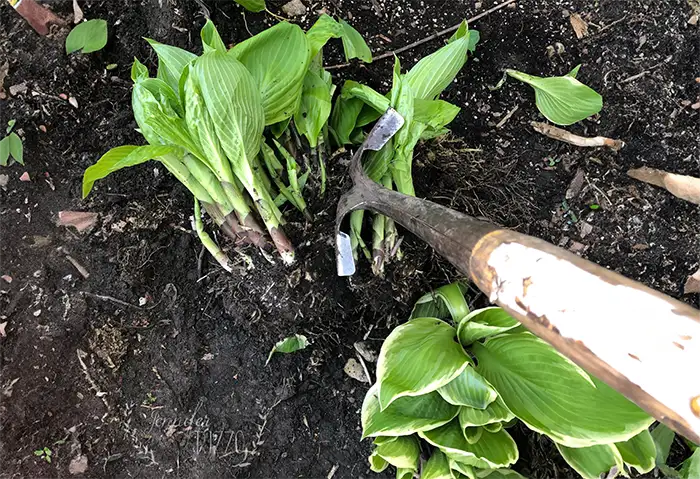
Gardening Month by Month – September: You Can Easily Divide ‘Hosta Plants’ With a Garden Fork. September is a Great Time For This.
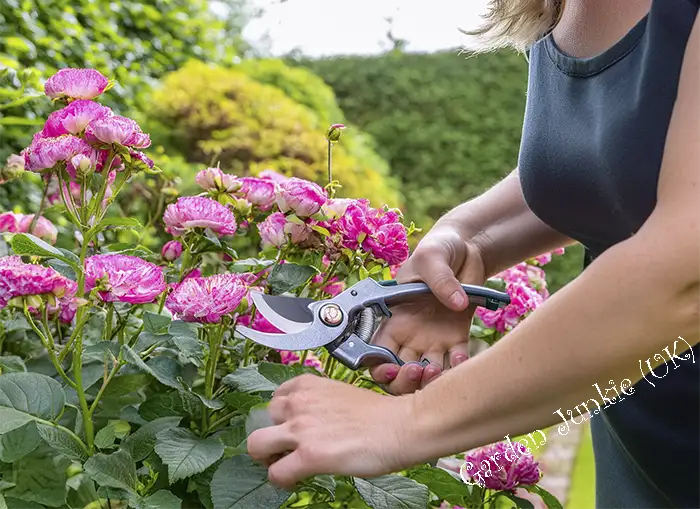
Gardening Month by Month – September: Deadhead Your Flower Regularly to Prolong Flowering And Encourage New Fresh Blooms.
In September: Fruit & Veg
As the warmth of summer starts to fade, September becomes an important month for gardeners in the UK to concentrate on their fruit and vegetable plots. With numerous crops reaching their peak, it is vital to gather, preserve, and strategise for the upcoming seasons.
This month presents a special chance to evaluate your achievements of the recent growing season while establishing plans for future harvests of your fruits and vegetables.
In the fruit garden, September signals a season of plenty, as many tree fruits and soft fruits are ready to be harvested. On the other hand, in the vegetable garden, attention transitions from summer crops to preparing for the harvests of autumn and winter. By emphasising the care of your fruits and vegetables in September, UK gardeners can secure a steady supply of fresh produce for the entire year.
In addition though:
- It’s time to plan to harvest late-season apple cultivars like ‘Bramley’s Seedling‘, ‘Cox’s Orange Pippin‘, and ‘Egremont Russet‘ these apples can be suitably stored until December. Apples should be stored in a cool, dark place, like a cellar, shed, or garage, that’s rodent-proof.
- Raspberry growers should be thinking about ‘picking’ autumn-fruiting raspberry varieties in September such as ‘Joan J‘ or ‘Autumn Bliss‘.
- If you grow squashes, September is the time to gather your remaining summer squash like ‘Defender F1′ courgettes and ‘Sunburst’ patty pan squash.
- September is a good time to Net your brassicas, particularly Brussels sprouts like ‘Trafalgar F1‘ and purple sprouting broccoli ‘Red Arrow’.
- This month begin reducing nitrogen-rich fertilisers to allow plants to harden off before winter.
- In September you should start installing grease bands on apple and pear tree trunks to prevent ‘wingless winter moth females’ from climbing.
- Another project for September is to spray your fruit trees with a ‘winter wash‘ (winter washing fruit trees involves spraying them with a mixture of plant oils diluted with water) to control overwintering pests like aphid eggs and scale insects.
- Try applying a potassium-rich fertiliser (check our NPK post) to fruiting plants like tomatoes and peppers to aid ripening.
- It’s a good idea to regularly check for and remove any clubroot-infected brassicas, particularly in varieties not bred for resistance.
- Apply a thick mulch of well-rotted compost or ‘leaf mold’ around fruit trees and bushes.
- Prune stone fruit trees like cherry and plum to reduce the risk of ‘silver leaf disease’.
- Order your bare-root fruit trees for autumn planting, such as ‘Victoria‘ plum or ‘Conference‘ pear.
- Clear away and remove to the compost heap spent plants like ‘determinate’ tomato varieties.
- Sow green manures like field beans (Vicia faba) or winter rye (Secale cereale) on empty beds.
- September is the month for lifting and dividing rhubarb crowns of varieties like ‘Victoria‘ or ‘Timperley Early‘
- Test soil pH and amend as necessary for future planting.
- Sow hardy winter vegetables such as kale, spinach, and winter lettuce.
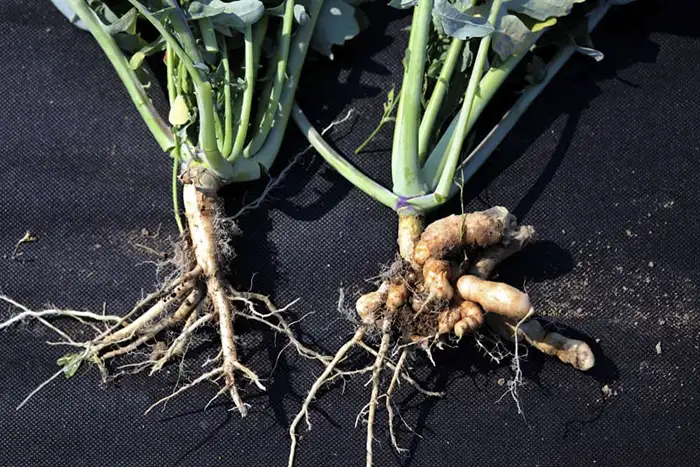
Gardening Month by Month – September: Its Always a Good Idea to Regularly Check Your Brassicas for Clubroot .
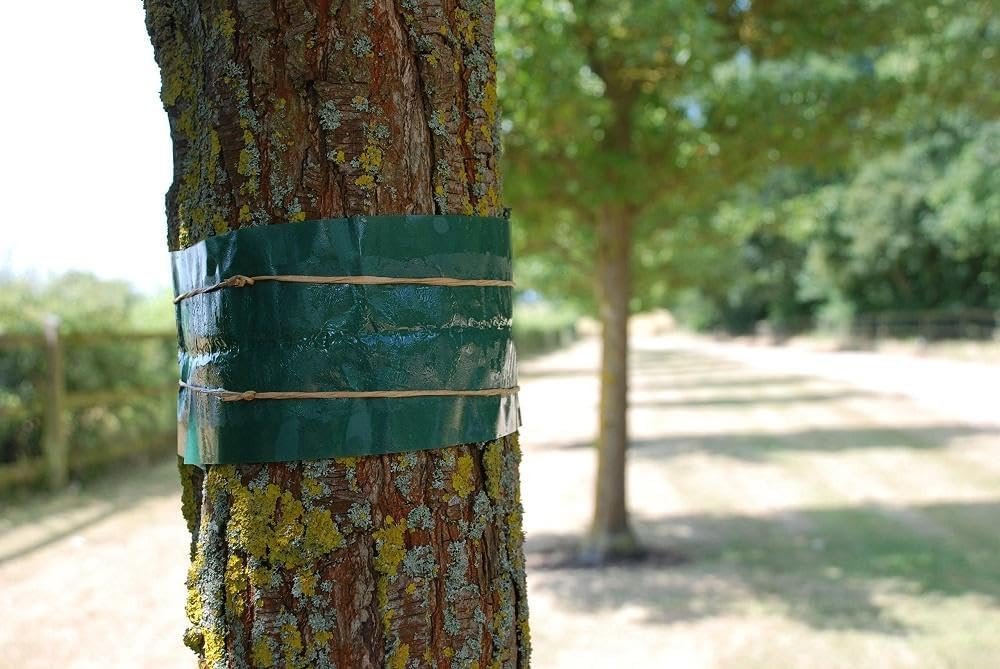
Gardening Month by Month – September: It is a Good Time to Start Installing Grease Bands on Your Apple and Pear Trees
In September: Pond Care
As autumn approaches in the UK, September marks a crucial transition period for pond owners. The water temperature begins to cool, and the ecosystem within the pond starts to prepare for the winter months ahead. This shift requires careful attention and specific maintenance tasks to ensure the health and vitality of both aquatic life and the pond environment itself.
During this month, pond plants begin to slow their growth, while fish adjust their feeding habits in response to the changing conditions. The ‘falling leaves’ from surrounding trees pose a new challenge, potentially affecting water quality if not cleared quickly. It’s also a time to reflect on the past season’s successes and challenges, making necessary adjustments to promote a thriving aquatic habitat through the cooler months and into the next spring.
For UK pond owners, September is the ideal time to perform a series of essential tasks that will help maintain water clarity, support fish health, and prepare the pond for the winter season. These activities range from cleaning and maintenance to adjusting feeding routines and planning for temperature changes.
In addition though:
- Check and clean pond filters, removing debris and rinsing ‘filter media’ in pond water to preserve beneficial bacteria.
- Begin reducing feeding of fish like koi and goldfish as the water temperature drops below 10°C (50°F)
- Trim back marginal plants such as Typha latifolia (Bulrush) and Iris pseudacorus (Yellow Flag Iris)
- Test water parameters including pH, ammonia, and nitrite levels using a reliable test kit (e.g., API Pond Master Test Kit).
- September is a good time to perform a 25% water change to your pond, treating all new water with a de-chlorinator like Seachem Pond Prime.
- Continue to check for and remove any algae growth, particularly blanket weed (Cladophora species).
- As the cooler months are ahead September is a good time to inspect any pond liners for damage or leaks, repairing as necessary with a suitable pond liner repair kit.
- Clean and prepare your pond de-icers or heaters if you have them (e.g., Laguna PowerHeat Heated De-Icer) for the approaching winter.
- As the weather gets colder remove tender aquatic plants like water hyacinth (Eichhornia crassipes) for indoor winter storage.
- Divide and repot in September overgrown aquatic plants such as water lilies (Nymphaea species).
- Check fish for signs of disease or parasites, particularly Koi Herpesvirus (KHV) which can be prevalent in cooling waters. KHV can be reduced in cooling waters, possibly with no, mortalities, however, other fish can become persistently infected if action is not taken quickly to remove infected fish. There is no current treatment for KHV.
- Apply beneficial bacteria treatments (e.g., Microbe-Lift Autumn/Winter Prep) to help break down organic matter in the pond.
- Prune back those overhanging branches from nearby trees to reduce ‘leaf fall’ into the pond.
- Create a winter refuge for pond wildlife by stacking logs or stones near the pond’s edge.
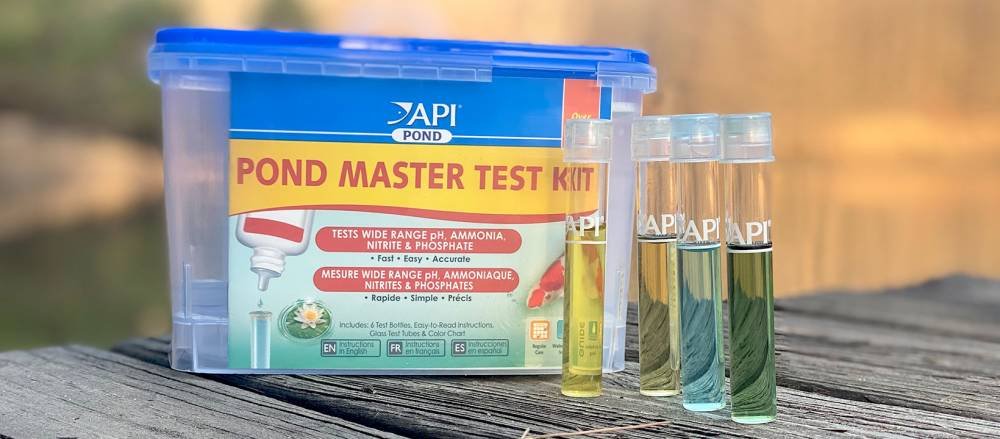
Gardening Month by Month – September: It’s Important to Test All of Your Ponds Water Parameters
In September: General Garden Maintenance
As summer fades into autumn, September as we have learned, generally marks a pivotal month for UK gardeners. Besides all our plants and pond life, September is also a time to focus on general garden maintenance. The changing season brings cooler temperatures and shorter days, signalling the need to prepare the garden for the months ahead. This transition period offers an ideal opportunity to assess the overall health of your garden, address any issues that have arisen over the summer, and lay the groundwork for a resilient outdoor space that can withstand the approaching winter.
General garden maintenance in September is about more than just tidying up; it’s a crucial time for soil care, lawn attention, and structural upkeep. These tasks help fortify your garden against autumn rains and winter frosts, ensuring that come next spring, your outdoor space will be ready to burst into life once again. It’s also an excellent time to reflect on the past growing season, making notes on what worked well and what might need adjustment in the coming year.
By focusing on these general maintenance tasks, UK gardeners can create a strong foundation for their gardens, promoting overall health and vitality that will pay dividends in the seasons to come. This proactive approach not only enhances the current appearance of your garden but also sets the stage for easier maintenance and more vigorous growth in the future.
In addition though:
- Clean and sharpen the gardening tools, that have served you well over the past year, oiling metal parts to prevent rust.
- Inspect and repair any fences, trellises, and other garden structures that need your attention.
- Clean and treat wooden garden furniture, safely storing or covering those items that won’t be used over the winter.
- Check patios and paths for weeds pushing through cracks. Remove these promptly to prevent damage.
- Check and clear gutters and drainpipes of debris to prevent water damage to buildings due to clogging.
- September is a great time to aerate and scarify lawns to improve drainage and remove ‘thatch’ (a layer of dead and living grass parts that build up between the soil and the growing grass).
- Apply an autumn lawn feed high in potassium to strengthen grass before winter.
- Service the lawnmower, sharpening blades and changing oil if necessary.
- Pressure wash patios, decking, and pathways to remove algae and prevent potential slippery surfaces for family and friends.
- Check for and repair any loose paving stones or bricks in garden paths.
- Clean and disinfect bird feeders and baths to prevent disease spread among garden wildlife.
- Reorganise the garden shed, disposing of out-of-date chemicals safely and restocking essential supplies.
- Conduct a soil pH test and amend the soil as necessary with lime or sulfur for optimal growing conditions next season.
- Finally, if they are about why not provide a home for a hedgehog at the bottom of the garden this winter? Hedgehogs are one of the UK’s most treasured wildlife species. Let’s look after them and keep them safe and warm from the elements and predators, like cats and foxes.
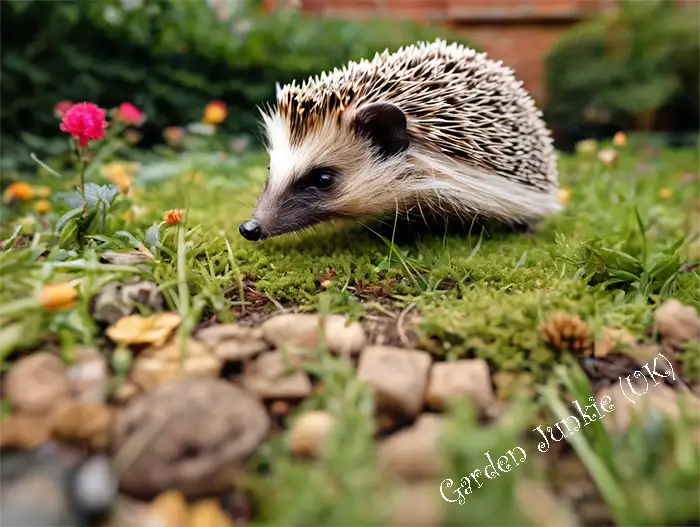
Gardening Month by Month – September: Why Not Provide a Hedgehog With a Home This Winter
FAQ’s
When should I stop mowing my lawn in autumn?
In the UK, you should generally continue mowing your lawn throughout September but gradually raise the cutting height of your mower. It’s generally recommended to stop mowing your lawn in late autumn, around October or November, when the grass growth slows down. This helps the lawn prepare for the winter months.
Is September a good time to plant trees and shrubs in the UK?
September is an excellent time to plant trees and shrubs in the UK. The soil is still warm from summer, encouraging root growth, while increased rainfall helps with plant establishment before the winter months. Focus on container-grown or root-balled specimens, and ensure you water them well until they’re established, especially if there’s a dry spell.
How do I prepare my roses for winter?
To prepare roses for winter in the UK, start in September by discontinuing fertilisation to discourage tender new growth. Continue deadheading to promote late blooms, but stop about 6 weeks before the first expected frost to allow plants to harden off. In late autumn (usually November), prune your roses lightly to remove any long, whippy stems that could be damaged by winter winds. Wait until late winter or early spring for the main pruning. For less hardy varieties, consider adding a thick mulch around the base of the plant for extra protection. Also, if you have standard roses, you might want to wrap the crown in horticultural fleece during particularly cold spells.
